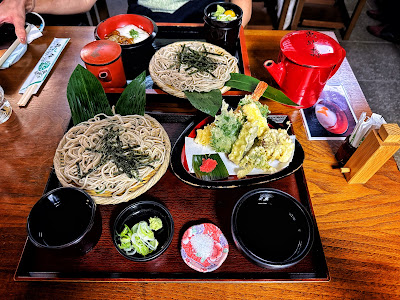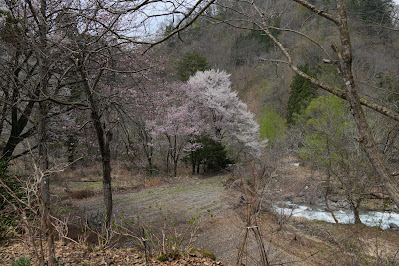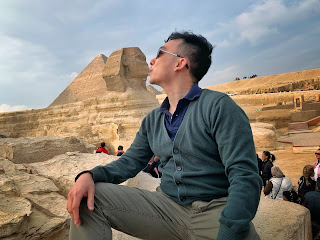 |
| Arashiyama Coast |
After Takayama, the coastal towns of Toyama Bay was our next stop on our way to Mount Tate. We took a train ride to the old fishing town of Himi. As we disembarked from the train, we looked around for the fishery, which was pretty easy to spot even from a distance: you just look for the cluster of birds circling over the area. There was just one thing I know about Toyama, which was to try the firefly squids. That sounded like as good a travel tip as any I've had.
The seaside was beautiful, and the walk across town was pleasant. But when we arrived at Himi Banya-gai for a late lunch, it was perhaps the most touristy spot in town. It’s purportedly a market selling sashimi fresh from the fishery, but we should have been tipped off by the parking bays for coach buses and the vast number of souvenirs shops. In hindsight, we should have just turned around and go somewhere else for lunch.
Was the sashimi truly fresher because it was next to a fishery? Doubtful, since seafood has to be flash-frozen and kept at a particular temperature for at least 15 hours before it’s safe to be eaten as sashimi. The 15 hours of downtime can cover quite a bit of ground - and countries - with modern transportation. We paid tourist prices for our food, and ate firefly squids off styrofoam trays at a fishmonger store while trying to ignore the thawed whole fish lying on ice beds next to us. The squid beaks were also not removed before the squids were served to us. We learnt the difference afterwards, when we ate firefly squids in a proper sushi restaurant back in Toyama City. My hope was that our sashimi had been at least treated correctly with at least 15 hours of freezing, and that they weren’t just served straight from the sea.
 |
| Firefly squid and halfbeak sashimi |
Do I sound grouchy? Toyama gets better, I promise! Birdwatchers would be charmed by the birds that clustered around the fishery. Here's a flock of eagles on the beach that we spent too much time stalking. I'd never seen them in a flock like this before.
We spent the rest of the day a few stations down in Amarashiya Coast. The coastal train, coloured in a pleasing saturated orange, was perfectly lit by the orange sun. We caught a beautiful sunset by the beach, and watched the colours of the sky deepened into purple.
We reached Toyama city in time for dinner, and we took the tram downtown to downtown for our first proper meal in Toyama Bay. Ebizushi is a local sushi restaurant, very local, and it was a wonderful experience. We again were the only tourists in the house, but they had an English menu.
We had more firefly squids, these ones properly-prepared with the removal of their hard beaks (yeah okay I’ll stop being bitter now). Thick-cut yellowtail and sweet prawns are also some of the region’s other delicacies.
Can I also just point out that Toyama is the most tourist-friendly city so far on our trip? As we checked into the hotel, the concierge passed us two sets of city map and a few stubs of complimentary tram tickets to make our way around the city, which we used to get to the restaurant. How great was that!
There's more to Toyama than uninspiring fish markets (Okay, that was the last dig, I promise.) The next day, we visited Unazuki Onsen, an onsen town located at the base of the alps. Part of the journey was made via the shinkansen, which was an absolute engineering marvel. We travelled 35km in just 12 minutes, or a whopping average speed of 175km/hr. Despite the high speed, the ride was smooth and we barely felt the acceleration and deceleration. The shift in speed had been so gentle, a fellow passenger's water bottle sitting on his fold-out tray didn’t budge at all throughout the entire ride.
We stopped for a spot of breakfast at ふくる, a cutesy bakery selling freshly baked baumkuchen next to Shin-Kurobe Station. It’s a circular layered cake originating from Germany, baked by “painting” each cake layer individually on a rotating spit as the cake cooks in the oven. It’s incredibly labour intensive, and while I’ve read that it is not all that common to be found in Germany anymore, the craft was picked up in Japan and became quite popular here.
Hot spring water is in such abundance in this town, the water fountain at Unazuki Onsen Station pumps spring water - steaming in the cool air - through the fountain.
We tried the locally-famous Alpen cheesecake (a pyramid-shaped cheesecake that melts within 10 minutes!), then took the trolley tram ride through the Kurobe Gorge.
The tram brought us through the surrounding landscape of rivers and mountains. The tramlines that go deeper into the mountains were closed since the 2024 Noto Peninsula Earthquake, so until they reopen, the furthest that we could go was to the Kurobe Dam.
Afterwards, you can walk through the area and visit the Kurobe Dam. There's a tram schedule so you'll roughly know when each tram passes through the tracks, and if you're lucky enough to come to the area just as they rumble past (we had to sprint at one point to get to a good spot when we heard them coming), the orange coloured trains makes for a pretty cute shoot.
We stopped by Oritate Station for a late lunch at Unazuki Beer Hall. It’s a small charming quiet little town nested in the valleys, with small plots of farmlands under the alps. We arrived too late for restaurant service, but we could have our food in take-out containers and were welcomed to eat it on the second floor lounge overlooking the brewery, though we took advantage of the nice evening to sit outdoors in the cool spring air.
Lunch was hearty and flavourful. The beer curry rice went well with the fried onion rings and prawn croquettes. We ordered a small serving of each of their draughts, which were excellent. (The beers weren’t hoppy, and were done in a lighter Japanese style, but I like my beer that way). We finished off with a serving of their beer soft serve ice cream, which was a perfect way to end off our sojourn in Oritate.
Oops. We realised only after lunch that our round-trip ticket (taking us from Shin-Kurobe Station to Unazuki Station) didn't let us exit at other stations along the way, so getting off at Oritate for lunch was technically not permitted. But the train attendants were chill, and we managed to return back to Shin-Kurobe Station with our smiles, our slightly-hapless expressions and with no small amount of the general courtesy of the Japanese.
************
The next day was the main attraction in Toyama: crossing the Tateyama Kurobe Alpine Route. There are several destinations to explore when going through the mountains; in the summer and autumn, there were plenty of trails. In spring, the main attraction would be the towering snow walls of the alpine. We woke at 4am to arrange for baggage forwarding for our luggage, and afterwards, took an early train out to Tateyama. From there, we took the transport through the mountains to Bijodaira and then Midagahara.
The reason why there weren’t any trails in spring, as we learnt as we arrived, was because the trails were all under six feet of snow.
We stayed for a night in the mountains in Midagahara, and I would recommend anybody to stay a night too. We changed into their waterproof boots, strapped in snow shoes and walked out on the grounds. Some mountains, draped in black and shades of greys, and with rivets of snow down the sides, looked exactly like calligraphy paintings. Being up in the mountains with the whole afternoon free to wander around the snowy landscape was one of the most blissful part of our trip.
The snowfall had been so heavy over the winter, as we walked along the back of the hotel, what I thought to be short shrubs were in fact treetops. Snow had blanketed the entire ground and the forests into a flat canvass, and we could walk as far as we wanted to. It wasn’t the trails that we signed up for, but it was an absolutely gorgeous stay.
I’m glad that I brought the waterproof skiing attire that I wore in Boston. It was needed for snow, as were woollen socks, gloves, and water-resistant hiking boots. Bring your thickest, waterproof clothes!
In hindsight though, because no trails are open in spring and we were staying the night, we didn’t need to take an early train from Toyama. (We were at Dentetsu Toyama Station at 5am to arrange for baggage forwarding and to board our train for the alpine mountains). We probably could have slept in for the morning and then go for an early lunch in the city before coming up the mountains. I still would have stayed for the night; the entire journey through the alpines was a crowded one, but on that leisurely afternoon, as the two of us walked around the wintry mountainside with nowhere to be and nothing else to do, it felt like pure joy. We walked for hours until we couldn’t feel our noses, returned to our resort for tea and hot chocolate until we warmed up, then headed back out again to watch the sunset.
When we were thoroughly chilled by the end of the day, we visited the resort’s hot onsen, and then went for dinner. I was a bit skeptical of the dinner that was included as part of our stay in Midagahara Hotel, because the area, high up in the mountains, wasn’t particularly accessible. In fact, I packed snacks, beer and sake in our overnight bag.
But like into many things, Japan aim to surpass all expectations. Not only was the multi-course meal incredible, there were a huge selection of drinks - beer, sake and spirits - all of which were free flow. I spotted the same exact sake that I brought up, actually.
You can help yourself to the pours, and there was also a staff there to recommend and mix drinks for you if you like. We chatted at the sake station for a bit. He beamed at my sake knowledge but also asked where I learnt to pronounce the terms from. My pronunciation must’ve been horrendous. (I didn’t have the heart to tell them that I learnt sake from a podcast hosted by two Americans; but I can't blame them for my off-tenor pronunciation of every word. I was never great with languages✌🏻.)
It snowed heavily that night, a rare occurrence in April, but there we go. The hotel’s star gazing event was cancelled on account of the poor weather, and the heavy snow even in the next morning, scuttled our plans for photography. Still, we were delighted with the snow in the way that only people from tropical countries get. We had breakfast and then walked around the freshly powdered ground.
Breakfast was pretty good, and we ate way too much of the brined firefly squids. I also found a most delightful treat labelled Salted Kelp. It has a firm gummy consistency, and then the salt flavour slowly builds up before releasing a burst of kelp flavours at the end.
The fresh snow persisted as we continued up to Murodo, with the occasional pellet-sized hail. It soon turned into a snowstorm up there: the temperature plunged to -7C, the ski slopes and the snow wall closed, and the signs warning of ‘hypothermia within 30 minutes’ came up.
True to the warnings, the snow and cold became too much to handle after more than a few minutes walk. Luckily, the transportation system was still operating. As we reached Kurobe Dam, the snow lessened just enough for photography.
It was a gorgeous stay, and the trip was beautiful even with a snowstorm.
Recent Japan Travels:
Osaka in Spring 2025: Osaka City (Part 1)
Osaka in Spring 2025: Kyoto and Uji (Part 2)
Osaka in Spring 2025: Hida-Takayama and Shirakawa-Go (Part 3)
Osaka in Spring 2025: Toyama and the Alpine Trail (Part 4)
Osaka in Spring 2025: Matsumoto, Nagano: (Part 5)
















































































